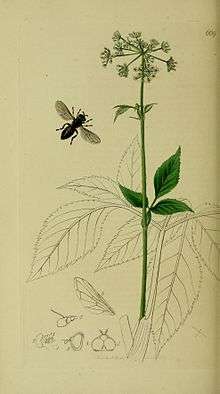Trichopsomyia
| Trichopsomyia | |
|---|---|
 | |
| Trichopsomyia flavitarsisIllustration in British Entomology | |
| Scientific classification | |
| Kingdom: | Animalia |
| Phylum: | Arthropoda |
| Class: | Insecta |
| Order: | Diptera |
| Family: | Syrphidae |
| Subfamily: | Eristalinae |
| Tribe: | Pipizini |
| Genus: | Trichopsomyia Williston, 1888 |
Trichopsomyia is a genus of Hoverflies, from the family Syrphidae (flower flies), in the order Diptera.[1][2]
Biology
Hover flies like the Trichopsomyia are small flies with large heads and eyes, and small antennae. Their bodies are medium to slender, with a waist that is not significantly narrow, unless it is a wasp mimicking species. They have one pair of clear wings, and the banded forms have yellow and black bands. Hoverflies resemble wasps or bees because of their black and yellow-striped abdomens. However, they are actually members of a fly family that have evolved to mimic wasps and bees for protection.[3]
Hoverfly larvae are flattened, legless and maggot-like. Most are green or brown in colour. They are carnivorous and eat aphids.
Species
- T. apisaon Walker, 1849
- T. australis (Johnson, 1907)
- T. flavitarsis (Meigen, 1822)
- T. joratensis Goeldlin, 1997
- T. litoralis Vockeroth, 1988
- T. lucida (Meigen, 1822)
- T. nigritarsis (Curran, 1924)
- T. occidentalis (Townsend, 1897)
- T. pubescens (Loew, 1863)
- T. recedens (Walker, 1852)
- T. rufithoracica (Curran, 1921)
- T. similis (Curran, 1924)
References
- ↑ Van Veen, M.P. (2004). Hoverflies of Northwest Europe, Identification Keys to the Syrphidae (Hardback). Utrecht: KNNV Publishing. p. 254. ISBN 90-5011-199-8.
- ↑ Stubbs, Alan E. & Falk, Steven J. (1983). British Hoverflies: An Illustrated Identification Guide. British Entomological & Natural History Society. p. 253, xvpp.
- ↑ http://australianmuseum.net.au/Hover-flies#sthash.NmPLiPFl.dpuf
This article is issued from
Wikipedia.
The text is licensed under Creative Commons - Attribution - Sharealike.
Additional terms may apply for the media files.